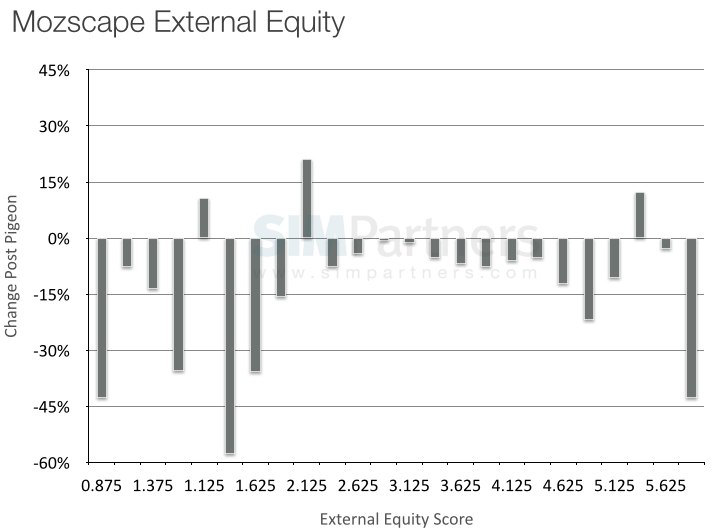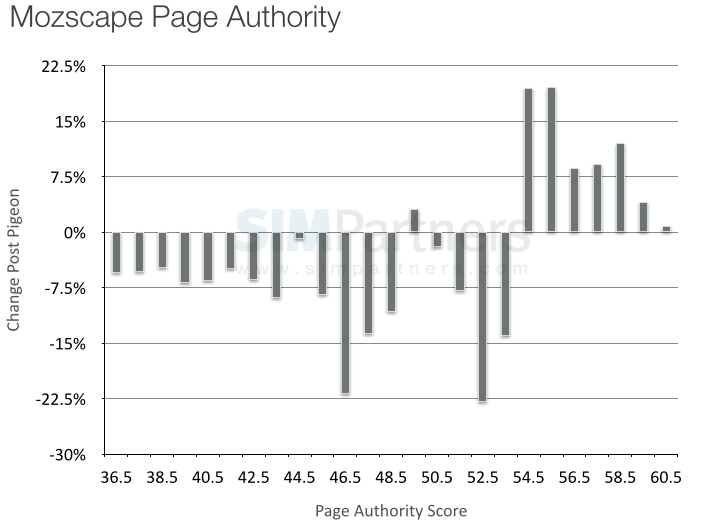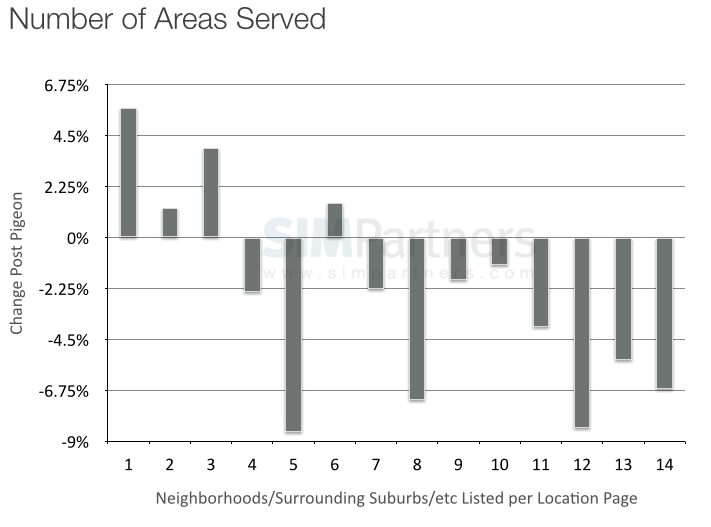Factors Affecting Pigeon — A 5,000 Page Case Study
How did Pigeon impact local business websites? Contributor Adam Dorfman shares his data and insights.

As reported extensively in Search Engine Land, Google released its Pigeon algorithm update to make local search results more useful and relevant by tying local search results more closely to traditional web search signals.
As oftentimes happens when Google drops an algorithm change, pundits, journalists and practitioners speculated and parsed the many potential causes of performance changes based on the Pigeon update.
At SIM Partners, we decided to do some homework first. We discovered that Pigeon has a number of implications for brands, such as the importance of attaching your local listings to strong domains.
Over a period of weeks, we studied a sample size of 5,000 location pages across several industries. We studied the performance of those pages during the period of July 11-23 and then July 25 to August 7, the two weeks immediately preceding and following the July 24 Pigeon launch date.
We wanted to know how Pigeon affects crucial factors such as website traffic and ranking performance among businesses that depend on local listings. After analyzing the numbers, we concluded the following:
1. Pigeon Does Not Equal Improved SERPs
The Pigeon update is not necessarily an improvement in the quality of search rankings. Typically, if we see a decrease in organic traffic after an algorithm update, we look to see if there is an increase in our conversion rate.
Why? Because while traffic is down, if the quality of traffic that Google is sending us is up, that would be considered a successful update from Google’s end.
Unfortunately, our study revealed a similar decrease in traffic and conversion for businesses that were negatively affected by the Pigeon update. In other words, Pigeon is doing nothing to affect the quality of your traffic and is just giving you less of it.
2. Strong Domains Matter
Local businesses need to attach their brands to strong domains. While Google has not explicitly confirmed that there is a bias toward brands in their ranking algorithm, many SEO practitioners have suspected as such since 2008, when then-CEO Eric Schmidt famously said that large brands served as a signal of quality, trusted content.
[blockquote cite=”Eric Schmidt, former CEO at Google”]”Brands are the solution, not the problem. Brands are how you sort out the cesspool.”[/blockquote]
With Pigeon, our immediate impression was that big brands with national reach and large, established directory sites were the winners.
In other words, if you are a big brand and/or have a strong domain, you are in good shape. To verify this assumption, we hooked into the Mozscape API and compared two key linking metrics (external equity and page authority) to see how performance changed post Pigeon. Here is what we discovered with external equity:
Granted, the data are fairly messy. But businesses that had a score of less than 2 experienced such a drop in performance that we concluded having a minimum set of links from external sources is table stakes in a post-Pigeon world — but having more than the minimum required isn’t going to make a difference.
More interesting was when we looked at page authority:
Here you can see there is a fairly consistent negative decrease in performance for locations that have a page authority score of less than 55, but a nice bump for those that have a score higher than that.
Since page authority takes into account internal links as well as external, it appears that internal link metrics have a stronger influence on performance than external.
So, what do the data mean overall?
If you are a national brand with a strong domain, make sure you have well optimized and mobile-friendly location pages clearly architected that live off of your website.
If you are a small to medium-sized business, continue working to establish your domain and build authoritative links toward it — but also look into barnacalizing your local optimization efforts.
3. Location Matters More Than Ever
Our study examined the impact of a local business’s proximity to the center of a city. We mapped all 5,000 listings to the center point of a city or town and asked, “Does proximity to the center matter to visibility in Google?”
We found that indeed, Google shows a preference for businesses that are closer to the city center, not farther away. In other words, proximity matters as a search signal.
We see a slight preference for locations just outside of urban centers in large markets but a sharp drop for any past 20 miles.
Proximity is a bigger factor in suburban or mid-tier markets. Google’s behavior parallels that of city planners which are trying to urbanize suburbs by making their downtowns more walkable and attractive to businesses.
In small towns, we suspect the large drop is due to a shift to 1- and 3-packs from 7-packs. If there is only one grocery store in town, it doesn’t make sense for Google to return seven local businesses.
Due to location-of-searcher becoming such a huge factor, I suspect that this factor will matter less in the long term; but, for now, the implication is this: If you are exploring the idea of opening a new location for your business, be as close to the downtown as you can.
4. Don’t Over-Optimize Your Website
Historically, when it came to optimizing for location-related keywords, I generally advised clients to be aggressive when adding location specific data to location pages.
If, for instance, the location page being optimized was for a grocery store in the Lincoln Park neighborhood of Chicago, a list of areas served might include the following: Lincoln Park, Lakeview, Boystown, Bucktown, Uptown, North Chicago, and Wrigleyville.
Because those neighborhoods are part of, or immediately surround, Lincoln Park, it makes sense to list those neighborhoods as their primary customer base comes from them.
So, what happened post Pigeon? Here are two data fields that show the performance change for location pages based on the number of zip codes listed as well as the number of areas served.
Compelling, right?
Without question, optimizing your content remains a sound practice on local sites as it does for any website. That said, it appears that the over-optimization dial has been turned up significantly with the Pigeon update.
Businesses that were aggressive in adding multiple zip codes and/or areas served may want to test removing some of them to see if performance improves.
I recommend brands take these near-term steps as you take into account the impact of Pigeon:
- Make sure you attach your local listings to strong domains. Clean up your listings on the most popular directories.
- If your local site shows a drop in performance, test to see if your site is over-optimized.
- Watch and learn! Pigeon is in constant flux; Google will continue to tinker with the algorithm, creating more turbulence for brands that ignore Pigeon and opportunities for those that take the time to understand its implications.
I do need to note that, as excited as I am to share these data with you, as always, correlation ≠ causation!

Source: https://xkcd.com/552/
For more information on our study, please check out my presentation from SMX East 2014:
Contributing authors are invited to create content for Search Engine Land and are chosen for their expertise and contribution to the search community. Our contributors work under the oversight of the editorial staff and contributions are checked for quality and relevance to our readers. The opinions they express are their own.
Related stories
New on Search Engine Land




